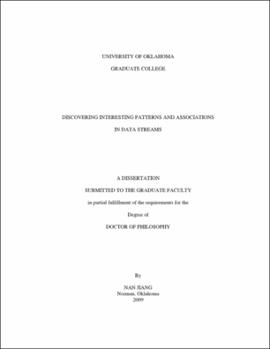| dc.contributor.advisor | Williams, Lee | |
| dc.creator | Jiang, Nan | |
| dc.date.accessioned | 2019-04-27T21:36:10Z | |
| dc.date.available | 2019-04-27T21:36:10Z | |
| dc.date.issued | 2009 | |
| dc.identifier | 9932998802042 | |
| dc.identifier.uri | https://hdl.handle.net/11244/319126 | |
| dc.description.abstract | A data stream is a sequence of items that arrive in a timely order. Different from data in traditional static databases, data streams are continuous, unbounded, usually come with high speed, and have a data value distribution that often changes with time (Guha, 2001). As more applications such as web transactions, telephone records, and network flows generate a large number of data streams every day, efficient knowledge discovery of data streams is an active and growing research area in data mining with broad applications. Traditional data mining algorithms are developed to work on a complete static dataset and, thus, cannot be applied directly in data stream applications. | |
| dc.description.abstract | One area of data mining research is to mine association relationship in a data set. Most of association mining techniques for data streams can be categorized into two types: those developed based on frequent patterns and those developed based on closed patterns. Due to the number of frequent patterns are often huge and redundant, non-informative patterns are contained in frequent patterns. An alternative way is to develop the association mining approaches for data streaming applications based on closed patterns, which generally represent a small subset of all frequent patterns, but provide complete and condensed information. In these researches, the closed pattern mining is the prerequisite condition for non-redundant and informative association mining. | |
| dc.description.abstract | In this dissertation, a sliding window technique for dynamic mining of closed patterns in data streams is proposed, and an approach of mining non-redundant and informative associations based on the discovered closed patterns is developed. The closed pattern and relevant association mining techniques are selected research area in this dissertation. First, the closed patterns for a given collection of data are currently the most compact data knowledge that can provide complete support information for all data patterns. | |
| dc.description.abstract | Compared with other techniques, the proposed closed pattern mining technique has potential to largely decrease the number of subsequent combinatorial calculations performed on the data patterns. Second, the memory requirement to store the closed patterns and relevant associations is generally lower than the corresponding frequent patterns and associations. In some data streaming applications, memory usage is an important measurement, because in these applications memory usage is the bottleneck for knowledge discovery. Third, the associations generated for data streams are the knowledge used to identify the relations within the data. The discovered relations can find their wide applications in many data streaming environments. | |
| dc.description.abstract | Different from the closed pattern mining techniques on traditional databases, which require multiple scans of the entire database, the proposed technique determines the closed patterns with a single scan. It is an incremental mining process; as the sliding window advances, new data transactions enter and old data transactions exit the window. But instead of regenerating closed patterns from the entire window, the proposed technique updates the old set of closed patterns whenever a new transaction arrives and/or an old transaction leaves the sliding window to obtain the current set of closed patterns. This incremental feature allows the user to get the most recent updated closed patterns without rescanning the entire updated database, which saves not only the computation time, but more importantly, the I/O operating time to load and write data from database to memory. Third, the proposed sliding window technique can handle both the insertion and deletion operations independently, which allows the user to adjust the sliding window size in different application environments. Furthermore, the proposed interesting patterns and association mining framework can handle different users' requests at the same time at their specified support and confidence thresholds, and interested input and output patterns. | |
| dc.description.abstract | The research includes both theoretical proofs of correctness for the proposed algorithms and simulation experiments to compare the proposed techniques with those existing in the literature using synthetic and real datasets. The utility of the proposed technique is applied to sensor network databases of a traffic management and an environmental monitoring site for missing data estimation purpose. | |
| dc.format.extent | 167 pages | |
| dc.format.medium | application.pdf | |
| dc.language | en_US | |
| dc.relation.requires | Adobe Acrobat Reader | |
| dc.subject | Data mining | |
| dc.subject | Association rule mining | |
| dc.subject | Computer algorithms | |
| dc.title | Discovering Interesting Patterns and Associations in Data Streams | |
| dc.type | text | |
| dc.type | document | |
| dc.thesis.degree | Ph.D. | |
| ou.group | College of Engineering::School of Computer Science | |
